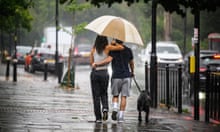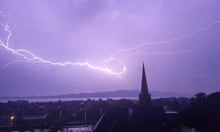Newspaper readers in the Britain’s northern half were used to scowling at the front pages every time they declared a sizzling summer. “It may well be sizzling in the south but it’s chucking it down in Hull/freezing in Wrexham/blowing a hoolie in Aberdeen” they grumbled, as they put on another cardigan or rescued the washing from a downpour.
Not this time. With a few exceptions (it’s still coat weather for those living in Shetland) much of Britain really has been outrageously hot this week. Whether it is asphalt melting, schools shutting or allotments withering, all but the most hardcore of climate crisis deniers now accept people are experiencing the effects of global heating in their own communities.
There has been a change of tone in the media coverage of the current heatwave. “If you’re not worried, you’re not listening,” tweeted James Mitchinson, editor of the Yorkshire Post, alongside a story showing the dried up reservoirs of God’s own county.
Yorkshire Water said its reservoirs were parched, despite most being 100% full in March, because they were serving communities who usually drink filtered river water. “Rivers are so low that we can’t use them, so we are having to move reservoir water through pipes to places like east Yorkshire,” said a spokesperson.
As the Green leader of Lancaster city council, Caroline Jackson has long put the climate emergency at the heart of her political agenda. But now others, – “even the local Conservatives” – are awake to the scale of the challenge, “which wouldn’t have been the case even two years ago”, she said. “We really are entering new territory.”

On Tuesday, she was considering an amendment to a motion at next week’s council meeting, where councillors were due to debate the creation of public “warm spaces” for local residents who could not afford to heat their homes this winter. “Now I’m thinking we need to amend it to look at creating cool spaces, too. It was 29C here last night, and I am very worried about people in our poorer communities spending money they don’t have on cooling their homes.”
Until now, people in Britain living outside London and the south-east have mostly experienced the climate crisis through flooding, rather than sunburn. Most of Lancaster city centre ended up under water in 2015, and “one in 100 year” flooding events have occurred multiple times in West Yorkshire’s Calder valley in the past decade alone.
In August 2019 torrential rain caused such damage to a reservoir wall in the Derbyshire town of Whaley Bridge that it was expected to collapse, prompting the evacuation of 1,000 residents.
And expect further extremes, said Mark McCarthy, manager of the National Climate Information Centre (NCIC) at the Met Office: “Our expectation from a changing climate is that the UK will experience wetter winters and drier summers on average. The increased risk of heavy rainfall brings flooding events as a consequence.”
The Met Office recently changed the definition for what it classes as an official heatwave, based on updated climatology, raising the threshold by 1C. “It now has to be 28C for at least three consecutive days to be classed as a heatwave in London and the south-east, and for more northerly regions it needs to be 25C,” McCarthy said.
Records are likely to be broken across the UK, he said, with Scotland expecting its hottest day on record, beyond the 32.9C set at Greycrook in the Scottish Borders in August 2003.
“The weather events in recent days are a reminder that heat and heat problems from climate change are not confined to the south-east of England. It is a risk for the whole country, particularly with a warming climate, because all areas can be exposed to temperatures that they have never been exposed to before,” said McCarthy.
Talking from Manchester, usually considered one of the UK’s wettest cities but sweltering in 36C heat on Tuesday, Pete Abel, a spokesperson for Manchester Friends of the Earth, warned: “This is not just a ‘hot summer’. These are record-shattering extreme day-and-night temperatures. Emley Moor in West Yorkshire broke the record for the hottest night-time temperature last night; today has seen the closure of the East Coast trainline.
“There are the wildfires in Chesterfield, Doncaster and Saddleworth Moor, not forgetting the flash flooding in Cumbria, Greater Manchester and Yorkshire earlier this year. This is what climate breakdown looks like.”









